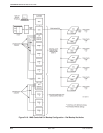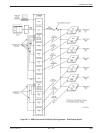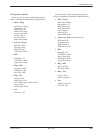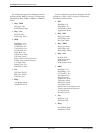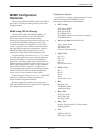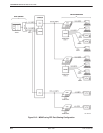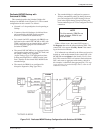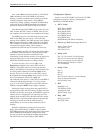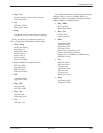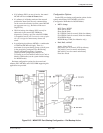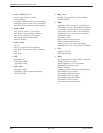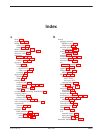
COMSPHERE 3600 Series Data Service Units
D-28 March 1999 3610-A2-GB41-60
Next, send a dial command, followed by a Dial Mode
(dm) command to each of the DBM-Ss performing
backup. (A routine command can be created to issue the
command sequence automatically.) Each DBM-S
responds by dialing a tributary Switched 56 DBM. When
connected, the pair of DBMs handshake and exchange
passwords, and enter Data mode (ready to send data).
After the tributary DSU-DBM has set up the call, each
DSU switches the DTE’s data to its DBM. After all calls
are completed, full restoration is accomplished at 56 kbps.
The DBM-Ss provide valid call setup messages to the
NMS. If the NMS does not receive a valid call setup
message from a DBM-S, the NMS operator issues another
dial command followed by a dm command to the DBM.
This completes the backup circuit and the host computer
can restart the network polling. When backup is
completed, the FEP line may be restarted, if necessary.
During backup, the DSU still reports the facility alarm
to the NMS. When the failure is corrected and the DDS
network is restored, the alarm is turned Off at the
workstation’s Alarm Monitor window. You can request an
aggregate Digital Test to one of the tributary DSUs to
ensure that the DDS network is working correctly.
To end the backup session via the NMS, issue
disconnect commands to the control DSU and all its
DBM-Ss. (The NMS restores all control and tributary
DSUs to the DDS network and drops all dial backup calls
by issuing an sf command and entering release in the
Standby Facility State field to the control DSU, and an
sf command and entering release in the Standby Facility
State field command, followed by a dial and
a q command in the Number to Dial field to each DBM-S
associated with the digital bridge). To end the backup
session via the SDCP, address the control DSU and each
DBM by issuing the DrBU (drop backup) command.
Ending the backup session causes the control DSU to
deactivate the bridge, and DSU timing (56 kbps) becomes
the DDS clock source once again. Each DBM-S signals its
tributary that it is dropping the call and hangs up. Each
tributary then switches back to the DDS network, and the
DDS network is again functional. (Between the time that
the bridge is deactivated and the DDS network is
reestablished, errors occur on those tributaries still in
backup.)
Pertinent configuration options for the central-site
bridge, the extended bridge, a DBM-S, and a tributary
DSU-DBM supporting this application follow. Please note
that all DBM-Ss here should be configured the same –
only the passwords and telephone numbers should differ.
The same holds true for the tributary DSU-DBMs.
Configuration Options
Set the control DSU-MCMP with Switched 56 DBM
configuration options as follows (Configuration
Worksheet for MCMP Mode):
• MUX – Setup
MUX Funct: MCMP
Share DevA: Disab
Share DevB: Disab
P1/2 FEPSh: Disab
P3/4 FEPSh: Disab
P5/6 FEPSh: Disa
MCMP Bckup: MCMP for tributaries
• Prt1 through Prt3 (Prt4 through Prt6 N/A)
Async→Sync: Disab
TxCarrSel: Const
RxCarrSel: Const
• PrtSp – DSU
Prt1: 19.2 for control; N/A for tributary
Prt2: 4.8 for control; N/A for tributary
Prt3: 4.8 for control; N/A for tributary
Prt4 through Prt6: Disab for control;
N/A for tributary
• PrtSp – Chan
Prt1: A
Prt2: B
Prt3: C
Prt4: None for control; C for top tributary,
None for bottom tributaries
Prt5 and Prt6: None
• DSU
Rate(Kbps): 56
TxClkSource: DDS
AggrSwitch: Enab
AgSw Timing: Aggr
• Diag – DSU
Diag Type: NonD
Disr Type: Br56



